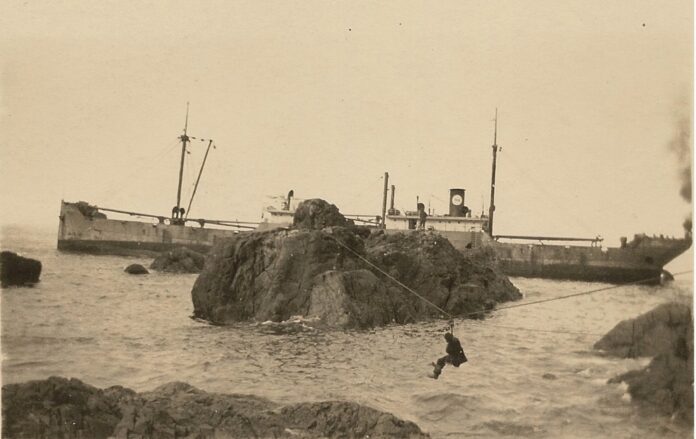
One hundred years ago, on Oct. 9, 1923, the MV Kennecott wrecked on the rocks in the Queen Charlotte Islands, B.C.
The ship, owned by the Alaska Steamship Co., was carrying copper from Alaska when it hit the rocks just before midnight the night earlier.
Lost in the wreck was 6,000 tons of copper ore from the richest copper mining area in the world, Kennecott. That mining area is now a national historic landmark within Wrangell-St. Elias National Park, but back then it had several copper ore mines and the mill town of McCarthy.
The value of the ship’s cargo was $1 million in 1923, which would be worth over $17 million today, according to inflation calculators. The copper ore was on its way to Tacoma, Washington, where a smelter run by Asarco operated for decades before closing in 1985 due to regulations and a recession.
The Kennecott, which was on her maiden voyage from Alaska, also had 40,000 cases of salmon from the Copper River.
“The Kennecott broke up and sank after a failed salvage attempt and on the evening of October 23 Captain Laughing Jack was standing on the deck of the salvage steamer Algerine as it headed south toward Tacoma. As the voyage took him down Finlayson Channel past the site of his first ship wreck, he went overboard, his body never found,” according to an account at Tacomahistory.live. Read more about this shipwreck at the link below:
Fascinating history. The MV Kennecott was the ONLY ship ever built for Kennecott specifically to haul Alaskan copper ore. It was brand-new and on its maiden voyage. The ore on board would have mostly been from the Mother Lode mine–one of five copper mines feeding the Kennecott mill site in 1923. And in that year the ML was by far the greatest ore producer of the five minesites.
Kennecott was mostly a tunnel and drift hard rock mine with high ore concentration described as a mother load strike. There was also Bonanza and Discovery plus 2 more.
Ore was transported by rail to Cordova then steam shipped to Tacoma for smelting.
Where the defunct pebble prospect would have been open pit on the west side of the claims with an earthen dam and bucket dredge pond. The enormous amount of water would have been a toxic waste factory to that watershed and the finely ground ore with nuisance metals (leads), poisoning the water table and water flow all the way down to Lake Iliamna.
In contrast, Kennecott was an environmentally safe mine. My favorite mine.
Spot on 3rd Gen.
The defunct pebble project would without doubt definitely been more disastrous than a volcanic eruption of one of the volcanoes in the Alaska range spewing billions of tons of highly toxic gases and poisonous ash into the atmosphere to be spread across ALL of Alaska;s salmon spawning streams from headwaters to the ocean.
The Earth and all forms of life on it would be devastated as we know it.
In contrast the Kennicot mine was environmentally as safe as oil development on the slope if it werent for those pesky ships dumping 6000 tons of ore into the ocean where our salmon feed as well as 11,000,000 gallons of oil in Prince William sound killing all forms of life and never ever recover.
Hmmm maybe thats why our salmon runs have dwindled….a bit of food for thought???
And be sure to vote no on those pesky eruptions. Those will surely kill us all.
6000 tons of unprocessed ore on a sunken ship would do nothing, it’s when the ore is pulverized into a fine powder then released into water is when it becomes toxic.
You need to study mine ore reduction before you take crack pot shots from the hip 😉
Correction: “The value of the ship’s cargo was $1 million in 1923, which would be worth over $30 million today, according to (HONEST) inflation calculators.”
More history on Kennecott. ‘https://explorenorth.com/alaska/history/latouche.html
There are many fascinating stories of ship wrecks along the Alexander Archipelago. The Princess Sophia in 1918 likely being the absolute worst tragedy, since 280 souls perished after she grounded on a reef in Lynn Canal..
The Star of Benegal lost her crew, the entire salmon pack from a cannery in Wrangell along with 200 Chinese cannery workers when she went down in Sumner Straight.
The strangest wreck however might be the Claire Nevada, because after a dozen years or more after sinking she resurfaced during a storm and stuck fast to Eldred Rock!
Comments are closed.